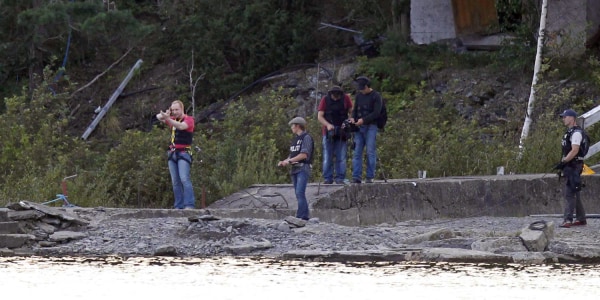When a man dressed in a police uniform began slaughtering young people at a Norwegian summer camp last week, one of the first to be killed was a real police officer named Trond Berntsen, who for years had worked in security at the camp.
Whether Officer Berntsen tried to stop the gunman is still being debated. But facing a man carrying multiple guns and ample ammunition, there was little he could do. Like most other police officers here, he had no weapon.
By law, Norwegian police officers must have authorization from their chief to gain access to a firearm, but they have rarely needed to ask, until recently. Violent crime has been steadily increasing, jolting a society used to leaving doors unlocked and children to play without fear. Coupled with growing criticism over the police’s slow response time to the attacks and confusion about the death toll, which was lowered Monday to 76 from 93, there are growing questions about whether the police are equipped to deal with the challenges.
Slideshow 57 photos
Norway in mourning after massacre
“Criminals are now carrying weapons, so some people now think that police officers should have weapons as well,” said Gry Jorunn Holmen, a spokeswoman for the Norwegian police union. Though she said it was too early to make any assessments, Ms. Holmen said the union had formed a commission to explore the issue. For the police, she said, “it’s getting tougher.”
It took police SWAT units more than an hour to reach the camp, on Utoya Island, after reports of the shooting came in. Officers had to drive to the shore across from the site of the shooting attack, and use boats to get to the island. A police helicopter was unable to get off the ground; news crews that reached the island by air could only watch as the gunman continued the massacre.
Anne Holt, Norway’s former justice minister, told the BBC: “That makes him a person that killed one person every minute. If the police had actually been there just a half an hour earlier, then 30 young lives would have been saved.”
Officer Berntsen, 51, who was the stepbrother of Norway’s crown princess, was remembered in a service on Monday. It was among the first of dozens of memorial services and funerals expected in the coming days after the rampage. The man identified by the police as the suspect, Anders Behring Breivik, most likely shot more rounds in the hourlong rampage than most Norwegian officers typically fire in a career.
Norway is internationally renowned for its low rates of violent crime, a fact that is a point of pride for many Norwegians. Murders, when they do occur, are front-page news here. In 2009, the last date for which official statistics were available, there were 29 murders in this country of 4.6 million. In Oslo, the capital, high-ranking officials rarely even bother with a security detail.
“You can walk around this city and bump into a leading government minister out promenading on the street and strike up a little conversation before you move on,” said Kristian Berg Harpviken, the director of the Peace Research Institute Oslo.
So it has been jarring for many in the wake of the attacks to see heavily armed commandos stationed outside the gingerbread facades of government buildings. The nation is now plainly on edge, and it is clear, experts say, that some things might have to change.
Norway is one of only three Western European countries lacking a fully armed police force. Most police officers in Britain and Iceland do not carry firearms, either. Norway’s neighbor, Sweden, began requiring its officers to carry guns in 1965.
Over the last decade, the frequency of rape and other assault has inched ever higher, statistics show. Murder rates, however, have remained stable.
The increasing presence of foreign criminal networks active in Norway is part of the reason for higher crime rates, Ms. Holmen and others said, though domestic criminal groups have also become more brazen. Just two days after the attacks, men in military fatigues shot a 27-year-old man to death in his home in southern Norway, Norwegian news outlets reported.
While Norwegian crime rates still look insignificant compared with a country like the United States, the uptick in violence, however small, has unsettled many here.
Currently, only beat police officers in patrol cars have immediate access to weapons. By law, however, they have to remain unloaded and locked in a box in the car unless authorization is given.
Some experts worry that arming police officers all the time will only lead to an escalation of violence as criminals arm themselves in response. For many, though, resistance to the idea has more to do with national pride.
“I would prefer to live in a society where police normally work unarmed,” said Johannes Knutsson, a professor of police research at the Norwegian Police University College. “It is a very forceful and symbolic sign to the citizens that this is a peaceful society.”
Elisa Mala contributed reporting.
This article, “Unsettling Wariness in Norway, Where Police Are Rarely Armed," first appeared in The New York Times.
